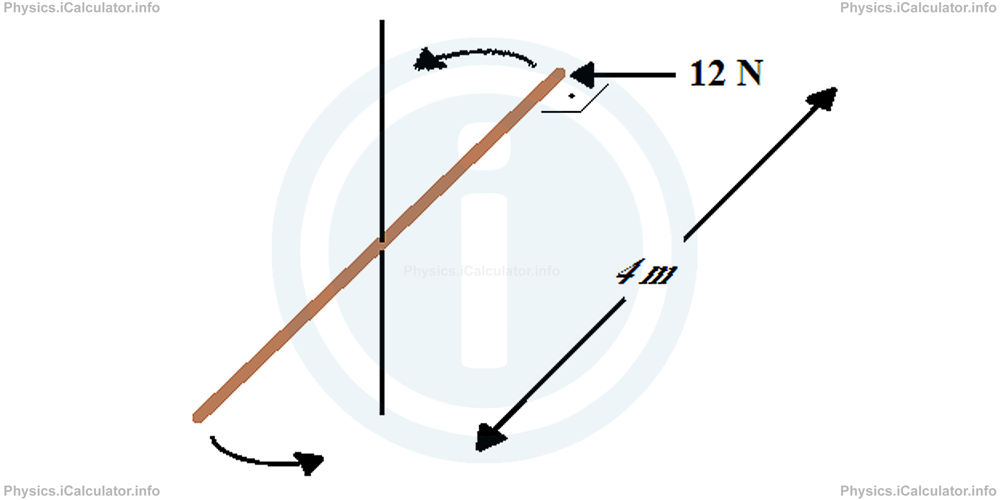Menu
Physics Lesson 7.2.4 - Newton's Second Law for Rotational Motion
Please provide a rating, it takes seconds and helps us to keep this resource free for all to use
Welcome to our Physics lesson on Newton's Second Law for Rotational Motion, this is the fourth lesson of our suite of physics lessons covering the topic of Dynamics of Rotational Motion, you can find links to the other lessons within this tutorial and access additional physics learning resources below this lesson.
Newton's Second Law for Rotational Motion
From the analogy used to study rotational quantities in terms of linear ones, it is easy to derive the Newton's Second Law for Rotational Motion. Thus, since moment of inertia I in rotational motion is analogue to mass m in linear one, and angular acceleration α is analogue to the linear acceleration a, and giving that the Newton's Second Law of Motion in Linear Dynamics is F = m × a, we can write the Newton's Second Law of Motion as
where τ is the torque, which is analogue to force in linear dynamics.
Example 3
A 12 N force pushes perpendicularly a 4 m long metal rod as shown in the figure.

If the mass of the rod is 1 kg, calculate
- Angular acceleration if the rod starts rotating from rest around its centre without any friction.
- The number of rotation the bar makes in 10 s.
Solution 3
a. First, we calculate the torque τ. Thus, since the bar rotates around its centre, the rotating arm is d = L / 2 = 4 m / 2 = 2 m and
= 2 m × 12 N
= 24 N × m
Now, let's calculate the rod's moment of inertia I. We use the formula of the long bar rotating around its centre (case 1). Thus, we have
= 1/12 × 1 × 42
= 1.25 kg × m2
Now, applying the Newton's Second law for rotational motion
we calculate the angular acceleration α (given that 1 N = 1 kg × m / s2):
= 24 kg × m2/s2/1.25 kg × m2
= 19.2 s - 2
= 19.2 rad/s2
b. First let's calculate the angular displacement φ. Given that the bar starts rotating from rest, we have ω0 = 0. Therefore, applying the kinematic equation
we obtain after substitutions (t = 10 s):
= 960 rad
Therefore, giving that 1 rot = 2π rad, we obtain for the number of rotations N:
= 960 rad/2 × 3.14 rad/rot
= 152.9 rotations
You have reached the end of Physics lesson 7.2.4 Newton's Second Law for Rotational Motion. There are 8 lessons in this physics tutorial covering Dynamics of Rotational Motion, you can access all the lessons from this tutorial below.
More Dynamics of Rotational Motion Lessons and Learning Resources
Whats next?
Enjoy the "Newton's Second Law for Rotational Motion" physics lesson? People who liked the "Dynamics of Rotational Motion lesson found the following resources useful:
- Newtons Second Law Feedback. Helps other - Leave a rating for this newtons second law (see below)
- Rotation Physics tutorial: Dynamics of Rotational Motion. Read the Dynamics of Rotational Motion physics tutorial and build your physics knowledge of Rotation
- Rotation Revision Notes: Dynamics of Rotational Motion. Print the notes so you can revise the key points covered in the physics tutorial for Dynamics of Rotational Motion
- Rotation Practice Questions: Dynamics of Rotational Motion. Test and improve your knowledge of Dynamics of Rotational Motion with example questins and answers
- Check your calculations for Rotation questions with our excellent Rotation calculators which contain full equations and calculations clearly displayed line by line. See the Rotation Calculators by iCalculator™ below.
- Continuing learning rotation - read our next physics tutorial: Centripetal Force
Help others Learning Physics just like you
Please provide a rating, it takes seconds and helps us to keep this resource free for all to use
We hope you found this Physics lesson "Dynamics of Rotational Motion" useful. If you did it would be great if you could spare the time to rate this physics lesson (simply click on the number of stars that match your assessment of this physics learning aide) and/or share on social media, this helps us identify popular tutorials and calculators and expand our free learning resources to support our users around the world have free access to expand their knowledge of physics and other disciplines.